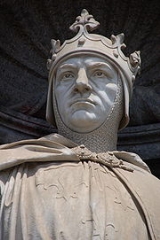
List of monarchs of Naples
Encyclopedia
The following is a list of rulers of the Kingdom of Naples
, from its first separation from the Kingdom of Sicily
to its merger with the same into the Kingdom of the Two Sicilies
.
Kingdom of Naples
The Kingdom of Naples, comprising the southern part of the Italian peninsula, was the remainder of the old Kingdom of Sicily after secession of the island of Sicily as a result of the Sicilian Vespers rebellion of 1282. Known to contemporaries as the Kingdom of Sicily, it is dubbed Kingdom of...
, from its first separation from the Kingdom of Sicily
Kingdom of Sicily
The Kingdom of Sicily was a state that existed in the south of Italy from its founding by Roger II in 1130 until 1816. It was a successor state of the County of Sicily, which had been founded in 1071 during the Norman conquest of southern Italy...
to its merger with the same into the Kingdom of the Two Sicilies
Kingdom of the Two Sicilies
The Kingdom of the Two Sicilies, commonly known as the Two Sicilies even before formally coming into being, was the largest and wealthiest of the Italian states before Italian unification...
.
| Portrait | | Name (Lifespan) | | Reign | Marriages | Notes |
|---|---|---|---|---|
| House of Anjou Capetian House of Anjou The Capetian House of Anjou, also known as the House of Anjou-Sicily and House of Anjou-Naples, was a royal house and cadet branch of the direct House of Capet. Founded by Charles I of Sicily, a son of Louis VIII of France, the Capetian king first ruled the Kingdom of Sicily during the 13th century... (1266-1382) |
||||
 |
Charles I (1226-1285) |
1266 - 7 January 1285 |
Beatrice of Provence Beatrice of Provence Beatrice of Provence , was a countess regnant of Provence. She was also a Queen consort of Sicily by marriage to King Charles I of Sicily.... (31 January 1246) seven children Margaret of Burgundy Margaret of Burgundy, Queen of Sicily Margaret of Burgundy was the second wife of Charles I of Sicily, and by marriage Queen consort of Sicily.The second daughter of Odo, Count of Nevers, and Maud of Dampierre, Margaret was Countess of Tonnerre by inheritance from 1262 until her death... (18 November 1268) one child |
son of Louis VIII of France Louis VIII of France Louis VIII the Lion reigned as King of France from 1223 to 1226. He was a member of the House of Capet. Louis VIII was born in Paris, France, the son of Philip II Augustus and Isabelle of Hainaut. He was also Count of Artois, inheriting the county from his mother, from 1190–1226... . Won the crown of Sicily as a papal fief and by conquest Right of conquest The right of conquest is the right of a conqueror to territory taken by force of arms. It was traditionally a principle of international law which has in modern times gradually given way until its proscription after the Second World War when the crime of war of aggression was first codified in the... from the Hohenstaufen Hohenstaufen The House of Hohenstaufen was a dynasty of German kings in the High Middle Ages, lasting from 1138 to 1254. Three of these kings were also crowned Holy Roman Emperor. In 1194 the Hohenstaufens also became Kings of Sicily... dynasty |
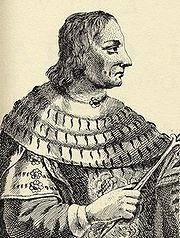 |
Charles II Charles II of Naples Charles II, known as "the Lame" was King of Naples, King of Albania, Prince of Salerno, Prince of Achaea and Count of Anjou.-Biography:... (1254-1309) |
7 January 1285 - 5 May 1309 |
Maria of Hungary (1270) fourteen children |
Son of Charles I of Naples. |
.jpg) |
Robert Robert of Naples Robert of Anjou , known as Robert the Wise was King of Naples, titular King of Jerusalem and Count of Provence and Forcalquier from 1309 to 1343, the central figure of Italian politics of his time. He was the third but eldest surviving son of King Charles II of Naples the Lame and Maria of Hungary... (1277-1343) |
5 May 1309 - 20 January 1343 |
Yolanda of Aragon Yolanda of Aragon Yolanda of Aragon was the daughter of Peter III of Aragon and Constance of Sicily. She married Robert of Naples but was never Queen of Naples since she died before her husband inherited the throne.- Family :... two children Sancha of Majorca Sancha of Majorca Sancha of Majorca was the second wife but only Queen consort of Robert of Naples.-Family:She was a daughter of James II of Majorca and his Queen consort Esclaramunda of Foix.... (July 1304) no children |
Son of Charles II Charles II of Naples Charles II, known as "the Lame" was King of Naples, King of Albania, Prince of Salerno, Prince of Achaea and Count of Anjou.-Biography:... . Inherited the crown in the absence of his nephew, Charles Martel Charles Martel of Anjou Charles Martel of the Angevin dynasty, also known as Charles I Martel, was the eldest son of king Charles II of Naples and Maria of Hungary, the daughter of King Stephen V of Hungary.... , who was busy claiming Hungary Kingdom of Hungary The Kingdom of Hungary comprised present-day Hungary, Slovakia and Croatia , Transylvania , Carpatho Ruthenia , Vojvodina , Burgenland , and other smaller territories surrounding present-day Hungary's borders... . |
.jpg) |
Joan I Joan I of Naples Joan I , born Joanna of Anjou, was Queen of Naples from 1343 until her death. She was also Countess of Provence and Forcalquier, Queen consort of Majorca and titular Queen of Jerusalem and Sicily 1343–82, and Princess of Achaea 1373/5–81.... (1328-1382) |
20 January 1343 - 12 May 1382 |
Andrew, Duke of Calabria Andrew, Duke of Calabria Andrew, Duke of Calabria was the second surviving son of Charles I of Hungary and Elizabeth of Poland... (1334) one child Louis I of Naples Louis of Taranto Louis I of Naples , of the House of Anjou, was the Prince of Taranto from 1346 and King of Naples from 1352. He was a son of Philip I of Taranto and Catherine II of Valois, Princess of Achaea. His paternal grandparents were Charles II of Naples and Maria of Hungary... (20 August 1346) two children James IV of Majorca James IV of Majorca James IV of Majorca was King of Majorca from 1349 until his death.James was the son of James III of Majorca and Constance of Aragon... (26 September 1363) no children Otto, Duke of Brunswick-Grubenhagen Otto, Duke of Brunswick-Grubenhagen Otto, Duke of Brunswick and Lunenburg was the fourth and last husband of Joan I of Naples. He also held the title of Prince of Taranto nicknamed as Otto the Tarantine.-Biography:... (25 September 1376) no children |
Daughter of Charles, Duke of Calabria Charles, Duke of Calabria Charles, Duke of Calabria was the son of King Robert of Naples and Yolanda of Aragon.-Biography:Born in Naples, he became Duke of Calabria in 1309 on his father's accession, and was created Vicar-General of the Kingdom of Sicily... . Inherited Primogeniture Primogeniture is the right, by law or custom, of the firstborn to inherit the entire estate, to the exclusion of younger siblings . Historically, the term implied male primogeniture, to the exclusion of females... the crown from her grandfather Robert. Dethroned by Pope Urban VI Pope Urban VI Pope Urban VI , born Bartolomeo Prignano, was Pope from 1378 to 1389.-Biography:Born in Itri, he was a devout monk and learned casuist, trained at Avignon. On March 21, 1364, he was consecrated Archbishop of Acerenza in the Kingdom of Naples... in 1381, conquered by her cousin, Charles, Duke of Durazzo Charles III of Naples Charles the Short or Charles of Durazzo was King of Naples and titular King of Jerusalem from 1382 to 1386 as Charles III, and King of Hungary from 1385 to 1386 as Charles II. In 1382 Charles created the order of Argonauts of Saint Nicholas... , and eventually strangled in prison. |
| Louis I (1320-1362) |
1352- 26 May 1362 |
Joan I of Naples Joan I of Naples Joan I , born Joanna of Anjou, was Queen of Naples from 1343 until her death. She was also Countess of Provence and Forcalquier, Queen consort of Majorca and titular Queen of Jerusalem and Sicily 1343–82, and Princess of Achaea 1373/5–81.... (1334) two children |
Husband of Joan I Joan I of Naples Joan I , born Joanna of Anjou, was Queen of Naples from 1343 until her death. She was also Countess of Provence and Forcalquier, Queen consort of Majorca and titular Queen of Jerusalem and Sicily 1343–82, and Princess of Achaea 1373/5–81.... and grandson of Charles II Charles II of Naples Charles II, known as "the Lame" was King of Naples, King of Albania, Prince of Salerno, Prince of Achaea and Count of Anjou.-Biography:... . Proclaimed king in right of his wife Jure uxoris Jure uxoris is a Latin term that means "by right of his wife" or "in right of a wife". It is commonly used to refer to a title held by a man whose wife holds it in her own right. In other words, he acquired the title simply by being her husband.... . |
|
| House of Anjou-Durazzo Capetian House of Anjou The Capetian House of Anjou, also known as the House of Anjou-Sicily and House of Anjou-Naples, was a royal house and cadet branch of the direct House of Capet. Founded by Charles I of Sicily, a son of Louis VIII of France, the Capetian king first ruled the Kingdom of Sicily during the 13th century... (1382-1435) |
||||
 |
Charles III Charles III of Naples Charles the Short or Charles of Durazzo was King of Naples and titular King of Jerusalem from 1382 to 1386 as Charles III, and King of Hungary from 1385 to 1386 as Charles II. In 1382 Charles created the order of Argonauts of Saint Nicholas... (1345-1386) |
12 May 1382 – 24 February 1386 |
Margaret of Durazzo (February 1369) 3 children |
Son of Louis of Durazzo Louis of Durazzo Louis of Durazzo was Count of Gravina and Morrone. He was the son of John of Gravina and Agnes of Périgord.In 1337, he was named Vicar- and Captain-General of the Kingdom of Albania. During the ascension of the Durazzeschi at the court of Naples during the reign of Joan I, he was one of the royal... , great-grandson of Charles II Charles II of Naples Charles II, known as "the Lame" was King of Naples, King of Albania, Prince of Salerno, Prince of Achaea and Count of Anjou.-Biography:... and adopted son of Joan I Joan I of Naples Joan I , born Joanna of Anjou, was Queen of Naples from 1343 until her death. She was also Countess of Provence and Forcalquier, Queen consort of Majorca and titular Queen of Jerusalem and Sicily 1343–82, and Princess of Achaea 1373/5–81.... . Conquered Joan and eventually had her strangled in prison. His rule was contested by Louis I of Anjou Louis I of Naples Louis I of Anjou , or Louis I of Naples, was the second son of King John II of France and Bonne of Luxembourg... . Inheriting the Hungary, he was eventually murdered at Visegrád Visegrád Visegrád is a small castle town in Pest County, Hungary.Situated north of Budapest on the right bank of the Danube in the Danube Bend, Visegrád has a population 1,654 as of 2001... . |
.jpg) |
Ladislaus (1376-1414) |
24 February 1386 -1389 1399-6 August 1414 |
Constance of Clermont (1390) no children Marie of Lusignan (12 February 1403) no children Mary of Enghien Mary of Enghien Mary of Enghien, also Maria d'Enghien, was Countess of Lecce from 1384 to 1446, and, by her second marriage, Queen of Naples and titular Queen of Sicily, Jerusalem, and Hungary .- Family :... (1406) no children |
Son of Charles III Charles III of Naples Charles the Short or Charles of Durazzo was King of Naples and titular King of Jerusalem from 1382 to 1386 as Charles III, and King of Hungary from 1385 to 1386 as Charles II. In 1382 Charles created the order of Argonauts of Saint Nicholas... . He was driven from the kingdom by Louis II Louis II of Naples Louis II of Anjou was the rival of Ladislaus as King of Naples. He was a member of the House of Valois-Anjou.-Biography:... |
| House of Valois-Anjou House of Valois-Anjou The Valois House of Anjou, or the Younger House of Anjou, was a noble French family, deriving from the royal family, the House of Valois. They were monarchs of Naples, as well as various other territories.... (1389-1399/1435-1442) |
||||
| The rule of the House of Durazzo was contested, as Joan I had appointed Louis I, Duke of Anjou, as her heir. The Dukes of Anjou led several military expeditions into the kingdom and reached an agreement with the House of Durazzo in 1426, succeeding them in 1435. | ||||
 |
Louis II Louis II of Naples Louis II of Anjou was the rival of Ladislaus as King of Naples. He was a member of the House of Valois-Anjou.-Biography:... (1377-1417) |
1389 - 1399 |
Yolande of Aragon Yolande of Aragon Yolande of Aragon, , was a throne claimant and titular queen regnant of Aragon, titular queen consort of Naples, Duchess of Anjou, Countess of Provence, and regent of Provence during the minority of her son... (1400) 5 children |
Son of Louis I Louis I of Naples Louis I of Anjou , or Louis I of Naples, was the second son of King John II of France and Bonne of Luxembourg... . Continued his father's claim and drove Ladislaus from Naples in 1389. He was ousted again in 1399. |
| House of Anjou-Durazzo Capetian House of Anjou The Capetian House of Anjou, also known as the House of Anjou-Sicily and House of Anjou-Naples, was a royal house and cadet branch of the direct House of Capet. Founded by Charles I of Sicily, a son of Louis VIII of France, the Capetian king first ruled the Kingdom of Sicily during the 13th century... (1266-1382) |
||||
 |
Joan II Joan II of Naples Joan II was Queen of Naples from 1414 to her death, upon which the senior Angevin line of Naples became extinct. As a mere formality, she used the title of Queen of Jerusalem, Sicily, and Hungary.... (1373-1435) |
6 August 1414 - 2 February 1435 |
William, Duke of Austria William, Duke of Austria William the Courteous was a member and head of the Leopoldinian Line, ruler of Carinthia, Styria and Carniola.Born in Vienna, he was the oldest son of Duke Leopold the Just and his wife, Viridis Visconti, and ruled in Carinthia, Styria and Carniola.His engagement with Hedwig of Hungary, youngest... no children James II, Count of La Marche James II, Count of La Marche James II of Bourbon-La Marche was the son of John I, Count of La Marche and Catherine of Vendôme.-Early life:... (1415) no children |
Daughter of Charles III Charles III of Naples Charles the Short or Charles of Durazzo was King of Naples and titular King of Jerusalem from 1382 to 1386 as Charles III, and King of Hungary from 1385 to 1386 as Charles II. In 1382 Charles created the order of Argonauts of Saint Nicholas... |
| House of Valois-Anjou House of Valois-Anjou The Valois House of Anjou, or the Younger House of Anjou, was a noble French family, deriving from the royal family, the House of Valois. They were monarchs of Naples, as well as various other territories.... (1389-1399/1435-1442) |
||||
 |
René René I of Naples René of Anjou , also known as René I of Naples and Good King René , was Duke of Anjou, Count of Provence , Count of Piedmont, Duke of Bar , Duke of Lorraine , King of Naples , titular King of Jerusalem... (1409-1480) |
2 February 1435 - 1442 | Isabelle of Lorraine (1420) 10 children Jeanne de Laval Jeanne de Laval -Sources:*Accounts of John Legay, fundraiser for the Queen of Sicily, the manuscript of the library of Angers, published in the History Anjou in 1900.*King Lecoy by René de la Marche.*Conduct of King René J. Levron.... (10 September 1454) no children |
Son of Louis III Louis II of Naples Louis II of Anjou was the rival of Ladislaus as King of Naples. He was a member of the House of Valois-Anjou.-Biography:... . After his brother's death, he was recognised as heir by Joan II Joan II of Naples Joan II was Queen of Naples from 1414 to her death, upon which the senior Angevin line of Naples became extinct. As a mere formality, she used the title of Queen of Jerusalem, Sicily, and Hungary.... and succeeded her upon her death. His rule was contested by Alfonso of Aragon Alfonso V of Aragon Alfonso the Magnanimous KG was the King of Aragon , Valencia , Majorca, Sardinia and Corsica , and Sicily and Count of Barcelona from 1416 and King of Naples from 1442 until his death... , whom Joan II had previously appointed her heir and who conquered the kingdom in 1442, forcing René to flee. Upon René's death, the claim to Naples was inherited by either his grandson, René II of Lorraine, or his nephew, Charles IV of Anjou, who died in 1481, leaving his claims to Louis XI of France Louis XI of France Louis XI , called the Prudent , was the King of France from 1461 to 1483. He was the son of Charles VII of France and Mary of Anjou, a member of the House of Valois.... . |
| House of Trastámara (1442-1501) | ||||
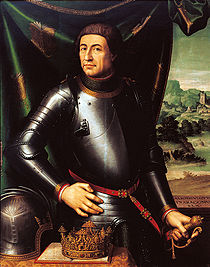 |
Alfonso I Alfonso V of Aragon Alfonso the Magnanimous KG was the King of Aragon , Valencia , Majorca, Sardinia and Corsica , and Sicily and Count of Barcelona from 1416 and King of Naples from 1442 until his death... (1396-1458) |
2 June 1442 - 27 June 1458 |
Maria of Castile Maria of Castile Maria of Castile was Queen consort of Aragon and Naples as the spouse of Alfonso V of Aragon. Maria acted as the regent of Aragon during the reign of her spouse, as he was absent during most of his reign; her regencies lasted between 1420 and 1423 and between 1432 and 1458... (1415) no children |
Son of Ferdinand I of Aragon Ferdinand I of Aragon Ferdinand I called of Antequera and also the Just or the Honest) was king of Aragon, Valencia, Majorca, Sardinia and Corsica and king of Sicily, duke of Athens and Neopatria, and count of Barcelona, Roussillon and Cerdanya... . He was appointed heir by Joan II Joan II of Naples Joan II was Queen of Naples from 1414 to her death, upon which the senior Angevin line of Naples became extinct. As a mere formality, she used the title of Queen of Jerusalem, Sicily, and Hungary.... in 1421, during her conflict with Louis III Louis III of Naples Louis III was titular King of Naples 1417–1426, Count of Provence, Forcalquier, Piedmont, and Maine and Duke of Anjou 1417–1434, and Duke of Calabria 1426–1434.... and persisted in his claim after falling out with Joan in 1423. He invaded the kingdom in 1436 and forced René to flee in 1442. |
 |
Ferdinand I Ferdinand I of Naples Ferdinand I , also called Don Ferrante, was the King of Naples from 1458 to 1494. He was the natural son of Alfonso V of Aragon by Giraldona Carlino.-Biography:... (1423-1494) |
27 June 1458 - 25 January 1494 |
Isabella of Taranto Isabella of Taranto Isabella of Taranto , born Isabella of Clermont, was a Princess of Taranto in her own right and first Queen consort of Ferdinand I of Naples.-Family:... (1444) six children Joanna of Aragon Joanna of Aragon Joanna of Aragon was an infanta of the Kingdom of Aragon and second Queen consort of Ferdinand I of Naples.... (14 September 1476) two children |
Illegitimate son of Alfonso I Alfonso V of Aragon Alfonso the Magnanimous KG was the King of Aragon , Valencia , Majorca, Sardinia and Corsica , and Sicily and Count of Barcelona from 1416 and King of Naples from 1442 until his death... and iraldona Carlino. Appointed heir in his father's testament Will (law) A will or testament is a legal declaration by which a person, the testator, names one or more persons to manage his/her estate and provides for the transfer of his/her property at death... . Due to his illegitimate birth, his claim was controversial and contested by René's son John, Duke of Lorraine John II, Duke of Lorraine John II of Anjou was Duke of Lorraine from 1453 to his death. He inherited the duchy from his mother, Duchess Isabelle, during the life of his father, Duke René of Anjou, also Duke of Lorraine and titular king of Naples... 1460-1464 and Charles VIII of France Charles VIII of France Charles VIII, called the Affable, , was King of France from 1483 to his death in 1498. Charles was a member of the House of Valois... , who took up the Angevine claims, after 1493. |
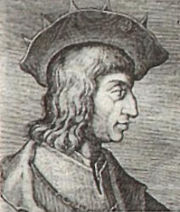 |
Alfonso II Alfonso II of Naples Alfonso II of Naples , also called Alfonso II d'Aragon, was King of Naples from 25 January 1494 to 22 February 1495 with the title King of Naples and Jerusalem... (1448-1495) |
25 January 1494 - January 1495 |
Ippolita Maria Sforza Ippolita Maria Sforza Ippolita Maria Sforza , Duchess of Calabria, was a member of the powerful Italian condottieri Sforza family which ruled the Duchy of Milan from 1450 until 1535... (10 October 1465) three children Trogia Gazzela two children |
Son of Ferdinand I of Naples Ferdinand I of Naples Ferdinand I , also called Don Ferrante, was the King of Naples from 1458 to 1494. He was the natural son of Alfonso V of Aragon by Giraldona Carlino.-Biography:... . Abdicated in face of the invasion of Charles VIII of France Charles VIII of France Charles VIII, called the Affable, , was King of France from 1483 to his death in 1498. Charles was a member of the House of Valois... and retreated to a monastery, where he died in December 1495. |
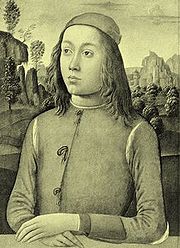 |
Ferdinand II Ferdinand II of Naples Ferdinand II or Ferrante II of Naples , sometimes known as Ferrandino, was King of Naples from 1495 to 1496... (1469-1496) |
January 1495 - 7 September 1496 |
Joan of Naples (1496) no children |
Son of Alfonso II Alfonso II of Naples Alfonso II of Naples , also called Alfonso II d'Aragon, was King of Naples from 25 January 1494 to 22 February 1495 with the title King of Naples and Jerusalem... . His rule was contested by Charles VIII of France Charles VIII of France Charles VIII, called the Affable, , was King of France from 1483 to his death in 1498. Charles was a member of the House of Valois... . |
 |
Frederick Frederick IV of Naples Frederick IV , sometimes known as Frederick I or Federico d'Aragona, was the last King of Naples of the House of Trastámara, ruling from 1496 to 1501... (1452-1504) |
7 September 1496 - 1501 |
Anne of Savoy Anne of Savoy Anne of Savoy, Princess of Squillace, Altamura, and Taranto was the first wife of King Frederick IV. She died 16 years before he succeeded to the Neopolitan throne, so she was never queen consort... (11 September 1478) one child Isabella del Balzo Isabella del Balzo Isabella of Balzo was the second consort and only Queen consort of Frederick IV of Naples.-Family:She was a daughter of Pietro del Balzo, Duke of Andria and Maria Donata Orsini... (28 November 1486) five children |
Son of Ferdinand I Ferdinand I of Naples Ferdinand I , also called Don Ferrante, was the King of Naples from 1458 to 1494. He was the natural son of Alfonso V of Aragon by Giraldona Carlino.-Biography:... . He was conquered by Louis XII of France Louis XII of France Louis proved to be a popular king. At the end of his reign the crown deficit was no greater than it had been when he succeeded Charles VIII in 1498, despite several expensive military campaigns in Italy. His fiscal reforms of 1504 and 1508 tightened and improved procedures for the collection of taxes... and Ferdinand II of Aragon Ferdinand II of Aragon Ferdinand the Catholic was King of Aragon , Sicily , Naples , Valencia, Sardinia, and Navarre, Count of Barcelona, jure uxoris King of Castile and then regent of that country also from 1508 to his death, in the name of... and died in exile at Tours Tours Tours is a city in central France, the capital of the Indre-et-Loire department.It is located on the lower reaches of the river Loire, between Orléans and the Atlantic coast. Touraine, the region around Tours, is known for its wines, the alleged perfection of its local spoken French, and for the... . |
| French rule (1501-1504) | ||||
 |
Louis III Louis XII of France Louis proved to be a popular king. At the end of his reign the crown deficit was no greater than it had been when he succeeded Charles VIII in 1498, despite several expensive military campaigns in Italy. His fiscal reforms of 1504 and 1508 tightened and improved procedures for the collection of taxes... (1462-1515) |
1501-1504 | Joan, Duchess of Berry Joan of France, Duchess of Berry Joan of France was briefly Queen consort of France as wife of King Louis XII of France, in between the death of her brother, Charles VIII, and the annulment of her marriage.... (8 September 1476) no children Anne of Brittany Anne of Brittany Anne, Duchess of Brittany , also known as Anna of Brittany , was a Breton ruler, who was to become queen to two successive French kings. She was born in Nantes, Brittany, and was the daughter of Francis II, Duke of Brittany and Margaret of Foix. Her maternal grandparents were Queen Eleanor of... (8 January 1499) 4 children Mary Tudor (9 October 1514) no children |
Taking up the Angevine House of Valois-Anjou The Valois House of Anjou, or the Younger House of Anjou, was a noble French family, deriving from the royal family, the House of Valois. They were monarchs of Naples, as well as various other territories.... claim, he conquered the kingdom but had to relinquish it to his erstwhile ally Ferdinand of Aragon Ferdinand II of Aragon Ferdinand the Catholic was King of Aragon , Sicily , Naples , Valencia, Sardinia, and Navarre, Count of Barcelona, jure uxoris King of Castile and then regent of that country also from 1508 to his death, in the name of... after the Battle of the Garigliano Battle of Garigliano (1503) The Battle of Garigliano was fought on December 29, 1503 between a Spanish army under Gonzalo Fernández de Córdoba and a French army commanded by Ludovico II, Marquis of Saluzzo.-Preliminary phase:... . His successors continued their claim until 1559. |
| Spanish rule (1504-1647) | ||||
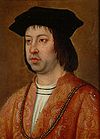 |
Ferdinand III Ferdinand II of Aragon Ferdinand the Catholic was King of Aragon , Sicily , Naples , Valencia, Sardinia, and Navarre, Count of Barcelona, jure uxoris King of Castile and then regent of that country also from 1508 to his death, in the name of... (1452-1516) |
1504 - 23 January 1516 |
Isabella I of Castile Isabella I of Castile Isabella I was Queen of Castile and León. She and her husband Ferdinand II of Aragon brought stability to both kingdoms that became the basis for the unification of Spain. Later the two laid the foundations for the political unification of Spain under their grandson, Charles V, Holy Roman Emperor... (19 October 1469) five children Germaine of Foix Germaine of Foix Germaine of Foix was queen consort of Aragon as the second wife of Ferdinand II of Aragon, whom he married in 1505 after the death of his first wife, Isabella I of Castile.-Birth and background:... (1505) no children |
Son of John II of Aragon John II of Aragon John II the Faithless, also known as the Great was the King of Aragon from 1458 until 1479, and jure uxoris King of Navarre from 1425 until his death. He was the son of Ferdinand I and his wife Eleanor of Alburquerque... . Conquered the kingdom after the Battle of the Garigliano Battle of Garigliano (1503) The Battle of Garigliano was fought on December 29, 1503 between a Spanish army under Gonzalo Fernández de Córdoba and a French army commanded by Ludovico II, Marquis of Saluzzo.-Preliminary phase:... . |
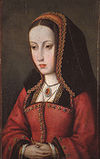 |
Joan III Joanna of Castile Joanna , nicknamed Joanna the Mad , was the first queen regnant to reign over both the Crown of Castile and the Crown of Aragon , a union which evolved into modern Spain... (1479-1555) |
23 January 1516 - 12 April 1555 |
Philip of Austria Philip I of Castile Philip I , known as Philip the Handsome or the Fair, was the first Habsburg King of Castile... (1496) six children |
Daughter of Ferdinand III Ferdinand II of Aragon Ferdinand the Catholic was King of Aragon , Sicily , Naples , Valencia, Sardinia, and Navarre, Count of Barcelona, jure uxoris King of Castile and then regent of that country also from 1508 to his death, in the name of... . Incapacitated due to her mental instability, the rule was exercised by her son, Charles Charles V, Holy Roman Emperor Charles V was ruler of the Holy Roman Empire from 1519 and, as Charles I, of the Spanish Empire from 1516 until his voluntary retirement and abdication in favor of his younger brother Ferdinand I and his son Philip II in 1556.As... , and her grandson, Philip Philip II of Spain Philip II was King of Spain, Portugal, Naples, Sicily, and, while married to Mary I, King of England and Ireland. He was lord of the Seventeen Provinces from 1556 until 1581, holding various titles for the individual territories such as duke or count.... . |
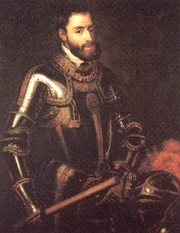 |
Charles IV Charles V, Holy Roman Emperor Charles V was ruler of the Holy Roman Empire from 1519 and, as Charles I, of the Spanish Empire from 1516 until his voluntary retirement and abdication in favor of his younger brother Ferdinand I and his son Philip II in 1556.As... (1500-1558) |
23 January 1516 - 25 July 1554 |
Isabella of Portugal (10 March 1526) three children |
Son of Philip of Austria Philip I of Castile Philip I , known as Philip the Handsome or the Fair, was the first Habsburg King of Castile... and Joanne III Joanna of Castile Joanna , nicknamed Joanna the Mad , was the first queen regnant to reign over both the Crown of Castile and the Crown of Aragon , a union which evolved into modern Spain... . also Holy Roman Emperor Holy Roman Emperor The Holy Roman Emperor is a term used by historians to denote a medieval ruler who, as German King, had also received the title of "Emperor of the Romans" from the Pope... and King of Spain, he ruled the kingdom for his incapacitated mother. Relinquished the rule to his son, Philip Philip II of Spain Philip II was King of Spain, Portugal, Naples, Sicily, and, while married to Mary I, King of England and Ireland. He was lord of the Seventeen Provinces from 1556 until 1581, holding various titles for the individual territories such as duke or count.... in 1554. |
 |
Philip II Philip II of Spain Philip II was King of Spain, Portugal, Naples, Sicily, and, while married to Mary I, King of England and Ireland. He was lord of the Seventeen Provinces from 1556 until 1581, holding various titles for the individual territories such as duke or count.... (1527-1598) |
25 July 1554 - 13 September 1598 |
Maria of Portugal (1543) one child Mary I of England Mary I of England Mary I was queen regnant of England and Ireland from July 1553 until her death.She was the only surviving child born of the ill-fated marriage of Henry VIII and his first wife Catherine of Aragon. Her younger half-brother, Edward VI, succeeded Henry in 1547... (1554) no children Elisabeth of Valois Elisabeth of Valois Elisabeth of Valois was the eldest daughter of Henry II of France and Catherine de' Medici.-Early life:She was born in the Château de Fontainebleau... (1559) two children Anna of Austria Anna of Austria (1549-1580) Anna of Austria , was Queen consort of Spain and Portugal by virtue of her marriage to King Philip II of Spain.-Family:She was the eldest daughter of Holy Roman Emperor Maximilian II and Maria of Spain... (4 May 1570) five children |
Son of Charles V Charles V, Holy Roman Emperor Charles V was ruler of the Holy Roman Empire from 1519 and, as Charles I, of the Spanish Empire from 1516 until his voluntary retirement and abdication in favor of his younger brother Ferdinand I and his son Philip II in 1556.As... . |
 |
Philip III Philip III of Spain Philip III , also known as Philip the Pious, was the King of Spain and King of Portugal and the Algarves, where he ruled as Philip II , from 1598 until his death... (1578-1621) |
13 September 1598 - 31 March 1621 |
Margaret of Austria (18 April 1599) five children |
Son of Philip II Philip II of Spain Philip II was King of Spain, Portugal, Naples, Sicily, and, while married to Mary I, King of England and Ireland. He was lord of the Seventeen Provinces from 1556 until 1581, holding various titles for the individual territories such as duke or count.... |
 |
Philip IV Philip IV of Spain Philip IV was King of Spain between 1621 and 1665, sovereign of the Spanish Netherlands, and King of Portugal until 1640... (1605-1665) |
31 March 1621 - 1647 |
Elisabeth of Bourbon (1615) seven children Mariana of Austria Mariana of Austria Mariana of Austria was Queen consort of Spain as the second wife of King Philip IV, who was also her maternal uncle... (1649) five children |
Son of Philip III Philip III of Spain Philip III , also known as Philip the Pious, was the King of Spain and King of Portugal and the Algarves, where he ruled as Philip II , from 1598 until his death... . Neapolitans rebelled against his viceroys, establishing the Neapolitan Republic Neapolitan Republic (1647) The Neapolitan Republic was a Republic created in Naples, which lasted from 22 October 1647 to 5 April 1648. It began after the revolt led by Masaniello and Giulio Genoino against the Spanish viceroys.... . |
| Neapolitan Republic Neapolitan Republic (1647) The Neapolitan Republic was a Republic created in Naples, which lasted from 22 October 1647 to 5 April 1648. It began after the revolt led by Masaniello and Giulio Genoino against the Spanish viceroys.... (1647-1648) |
||||
 |
Henry II, Duke of Guise Henry II, Duke of Guise Henry II de Lorraine, 5th Duke of Guise was the second son of Charles, Duke of Guise and Henriette Catherine de Joyeuse.-Life:... (1614–1664) |
22 October 1647 - 5 April 1648 |
no uncontroversial marriages | Taking up the Angevine House of Valois-Anjou The Valois House of Anjou, or the Younger House of Anjou, was a noble French family, deriving from the royal family, the House of Valois. They were monarchs of Naples, as well as various other territories.... claim, Henry was appointed Doge Doge Doge is a dialectal Italian word that descends from the Latin dux , meaning "leader", especially in a military context. The wife of a Doge is styled a Dogaressa.... of the Neapolitan Republic. He was captured when Naples was reconquered by the Spanish. |
| Spanish rule (1647-1700) | ||||
 |
Philip IV Philip IV of Spain Philip IV was King of Spain between 1621 and 1665, sovereign of the Spanish Netherlands, and King of Portugal until 1640... (1605-1665) |
1648 - 17 September 1665 |
Elisabeth of Bourbon (1615) seven children Mariana of Austria Mariana of Austria Mariana of Austria was Queen consort of Spain as the second wife of King Philip IV, who was also her maternal uncle... (1649) five children |
Son of Philip III Philip III of Spain Philip III , also known as Philip the Pious, was the King of Spain and King of Portugal and the Algarves, where he ruled as Philip II , from 1598 until his death... . |
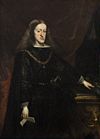 |
Charles V Charles II of Spain Charles II was the last Habsburg King of Spain and the ruler of large parts of Italy, the Spanish territories in the Southern Low Countries, and Spain's overseas Empire, stretching from the Americas to the Spanish East Indies... (1661-1700) |
17 September 1665 - 1 November 1700 |
Maria Luisa of Orléans (19 November 1679) no children Maria Anna of Neuburg (14 May 1690) no children |
Son of Philip IV Philip IV of Spain Philip IV was King of Spain between 1621 and 1665, sovereign of the Spanish Netherlands, and King of Portugal until 1640... |
| War of Spanish Succession (1701—1714) | ||||
| During the War of Spanish Succession, the Spanish crown was contested by Philip of Anjou Philip V of Spain Philip V was King of Spain from 15 November 1700 to 15 January 1724, when he abdicated in favor of his son Louis, and from 6 September 1724, when he assumed the throne again upon his son's death, to his death.Before his reign, Philip occupied an exalted place in the royal family of France as a... , of the House of Bourbon House of Bourbon The House of Bourbon is a European royal house, a branch of the Capetian dynasty . Bourbon kings first ruled Navarre and France in the 16th century. By the 18th century, members of the Bourbon dynasty also held thrones in Spain, Naples, Sicily, and Parma... , and Charles of Austria Charles VI, Holy Roman Emperor Charles VI was the penultimate Habsburg sovereign of the Habsburg Empire. He succeeded his elder brother, Joseph I, as Holy Roman Emperor, King of Bohemia , Hungary and Croatia , Archduke of Austria, etc., in 1711... , of the House of Habsburg. The was concluded with the Treaty of Rastatt Treaty of Rastatt The Treaty of Rastatt of 7 March 1714, ended hostilities between France and Austria at the end of the War of the Spanish Succession. It complemented the Treaty of Utrecht, which had, the previous year, ended hostilities with Britain and the Dutch Republic... , which gave Spain proper to Philip but the Netherlands and Naples to Charles. |
||||
| Austrian rule (1714-1734) | ||||
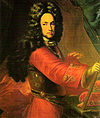 |
Charles VI Charles VI, Holy Roman Emperor Charles VI was the penultimate Habsburg sovereign of the Habsburg Empire. He succeeded his elder brother, Joseph I, as Holy Roman Emperor, King of Bohemia , Hungary and Croatia , Archduke of Austria, etc., in 1711... (1685-1740) |
7 March 1714 - 2 June 1734 |
Elisabeth Christine Elisabeth Christine of Brunswick-Wolfenbüttel Elisabeth Christine of Brunswick-Wolfenbüttel was Princess of Brunswick-Wolfenbüttel, Holy Roman Empress, German Queen, Queen of Bohemia and Hungary; and Archduchess of Austria by her marriage to Emperor Charles VI. She was renowned for her delicate beauty and also for being the mother of Empress... (1 August 1708) four children |
Son of Emperor Leopold I Leopold I, Holy Roman Emperor | style="float:right;" | Leopold I was a Holy Roman Emperor, King of Hungary and King of Bohemia. A member of the Habsburg family, he was the second son of Emperor Ferdinand III and his first wife, Maria Anna of Spain. His maternal grandparents were Philip III of Spain and Margaret of Austria... . Great-grandson of Philip II and Habsburg claimant to the Spanish crown, he won Naples in the War of Spanish Succession, but lost it to Spain in 1734 during the War of the Polish Succession War of the Polish Succession The War of the Polish Succession was a major European war for princes' possessions sparked by a Polish civil war over the succession to Augustus II, King of Poland that other European powers widened in pursuit of their own national interests... . |
| House of Bourbon (1734-1799) | ||||
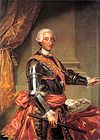 |
Charles VII Charles III of Spain Charles III was the King of Spain and the Spanish Indies from 1759 to 1788. He was the eldest son of Philip V of Spain and his second wife, the Princess Elisabeth Farnese... (1716-1788) |
2 June 1734 - 6 October 1759 |
Maria Amalia of Saxony Maria Amalia of Saxony Maria Amalia of Saxony was a German princess from the House of Wettin and was the wife of Charles III of Spain; she was the Queen consort of Naples and Sicily from 1738 till 1759 and then Queen consort of Spain from 1759 until her death in 1760... (1738) thirteen children |
Son of Philip V of Spain Philip V of Spain Philip V was King of Spain from 15 November 1700 to 15 January 1724, when he abdicated in favor of his son Louis, and from 6 September 1724, when he assumed the throne again upon his son's death, to his death.Before his reign, Philip occupied an exalted place in the royal family of France as a... . His armies conquered Naples in 1734 during the War of the Polish Succession War of the Polish Succession The War of the Polish Succession was a major European war for princes' possessions sparked by a Polish civil war over the succession to Augustus II, King of Poland that other European powers widened in pursuit of their own national interests... . In 1738, the Treaty of Vienna Treaty of Vienna (1738) The Treaty of Vienna or Peace of Vienna was signed on November 18, 1738. It ended the War of the Polish Succession. By the terms of the treaty, Stanisław Leszczyński renounced his claim on the Polish throne and recognized Augustus III, Duke of Saxony. As compensation he received instead the... recognized Naples as an independent kingdom under a cadet branch of the Spanish Bourbons. |
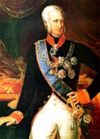 |
Ferdinand IV Ferdinand I of the Two Sicilies Ferdinand I reigned variously over Naples, Sicily, and the Two Sicilies from 1759 until his death. He was the third son of King Charles III of Spain by his wife Maria Amalia of Saxony. On 10 August 1759, Charles succeeded his elder brother, Ferdinand VI, as King Charles III of Spain... (1751-1825) |
6 October 1759 - 23 January 1799 |
Marie Caroline of Austria (12 May 1768) seventeen children Lucia Migliaccio of Floridia Lucia Migliaccio of Floridia Lucia Migliaccio, Duchess of Floridia was the second wife of Ferdinand I of the Two Sicilies. Their marriage was morganatic and Lucia was never a Queen consort.-Family:... (27 November 1814) no children |
Son of Charles VII Charles III of Spain Charles III was the King of Spain and the Spanish Indies from 1759 to 1788. He was the eldest son of Philip V of Spain and his second wife, the Princess Elisabeth Farnese... . Fled in face of the French invasion, which installed the Parthenopaean Republic Parthenopaean Republic The Parthenopean Republic was a French-supported republic in the territory of the Kingdom of Naples, formed during the French Revolutionary Wars after King Ferdinand IV fled before advancing French troops... . |
| Parthenopaean Republic Parthenopaean Republic The Parthenopean Republic was a French-supported republic in the territory of the Kingdom of Naples, formed during the French Revolutionary Wars after King Ferdinand IV fled before advancing French troops... (1799) |
||||
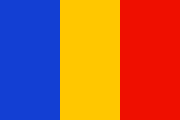 |
Directory | 23 January 1799 – 13 June 1799 |
Installed by the French army but ended by a peasant counter-revolution. | |
| House of Bourbon (1799-1806) | ||||
 |
Ferdinand IV Ferdinand I of the Two Sicilies Ferdinand I reigned variously over Naples, Sicily, and the Two Sicilies from 1759 until his death. He was the third son of King Charles III of Spain by his wife Maria Amalia of Saxony. On 10 August 1759, Charles succeeded his elder brother, Ferdinand VI, as King Charles III of Spain... (1751-1825) |
13 June 1799 - 30 March 1806 |
Marie Caroline of Austria (12 May 1768) seventeen children Lucia Migliaccio of Floridia Lucia Migliaccio of Floridia Lucia Migliaccio, Duchess of Floridia was the second wife of Ferdinand I of the Two Sicilies. Their marriage was morganatic and Lucia was never a Queen consort.-Family:... (27 November 1814) no children |
Son of Charles VII Charles III of Spain Charles III was the King of Spain and the Spanish Indies from 1759 to 1788. He was the eldest son of Philip V of Spain and his second wife, the Princess Elisabeth Farnese... . Restored after the demise of the Parthenopaean Republic. |
| Napoleonic client state (1806-1815) | ||||
 |
Joseph Bonaparte Joseph Bonaparte Joseph-Napoléon Bonaparte was the elder brother of Napoleon Bonaparte, who made him King of Naples and Sicily , and later King of Spain... (1768-1844) |
30 March 1806 - 8 July 1808 |
Julie Clary Julie Clary Marie Julie Bonaparte was Queen consort of Spain and the Indies, Naples and Sicily as the spouse of King Joseph Bonaparte, who was King of Naples and Sicily from January 1806 to June 1808, and later King of Spain and the Spanish West Indies from 25 June 1808 to June 1813.- Background:Julie Clary... (1 August 1794) three children |
Son of Carlo Buonaparte Carlo Buonaparte Carlo Maria Buonaparte was a Corsican lawyer and politician who briefly served as a personal assistant of the revolutionary leader Pasquale Paoli and eventually rose to become Corsica's representative to the court of Louis XVI... . Installed by his brother Napoleon Bonaparte Napoleon I Napoleon Bonaparte was a French military and political leader during the latter stages of the French Revolution.As Napoleon I, he was Emperor of the French from 1804 to 1815... as King of Naples, later replaced by his brother-in-law, Joachim Murat Joachim Murat Joachim-Napoléon Murat , Marshal of France and Grand Admiral or Admiral of France, 1st Prince Murat, was Grand Duke of Berg from 1806 to 1808 and then King of Naples from 1808 to 1815... . |
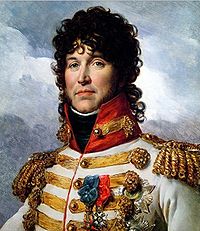 |
Joachim Murat Joachim Murat Joachim-Napoléon Murat , Marshal of France and Grand Admiral or Admiral of France, 1st Prince Murat, was Grand Duke of Berg from 1806 to 1808 and then King of Naples from 1808 to 1815... (1767-1815) |
1 August 1808 - 22 May 1815 |
Caroline Bonaparte Caroline Bonaparte Maria Annunziata Carolina Murat , better known as Caroline Bonaparte, was the seventh surviving child and third surviving daughter of Carlo Buonaparte and Letizia Ramolino and a younger sister of Napoleon I of France... (1 August 1794) three children |
Son of Pierre Murat-Jordy. Installed by his brother-in-law Napoleon Bonaparte Napoleon I Napoleon Bonaparte was a French military and political leader during the latter stages of the French Revolution.As Napoleon I, he was Emperor of the French from 1804 to 1815... as King of Naples. Deposed and executed at Pizzo, Calabria Pizzo, Calabria Pizzo is a seaport and comune in the province of Vibo Valentia , situated on a steep cliff overlooking the Gulf of Santa Eufemia.Fishing is one of the main activities, including that of tuna and coral.-History:... after the Hundred Days Hundred Days The Hundred Days, sometimes known as the Hundred Days of Napoleon or Napoleon's Hundred Days for specificity, marked the period between Emperor Napoleon I of France's return from exile on Elba to Paris on 20 March 1815 and the second restoration of King Louis XVIII on 8 July 1815... . |
| House of Bourbon (1815-1816) | ||||
 |
Ferdinand IV Ferdinand I of the Two Sicilies Ferdinand I reigned variously over Naples, Sicily, and the Two Sicilies from 1759 until his death. He was the third son of King Charles III of Spain by his wife Maria Amalia of Saxony. On 10 August 1759, Charles succeeded his elder brother, Ferdinand VI, as King Charles III of Spain... (1751-1825) |
22 May 1815 - 8 December 1816 |
Marie Caroline of Austria (12 May 1768) seventeen children Lucia Migliaccio of Floridia Lucia Migliaccio of Floridia Lucia Migliaccio, Duchess of Floridia was the second wife of Ferdinand I of the Two Sicilies. Their marriage was morganatic and Lucia was never a Queen consort.-Family:... (27 November 1814) no children |
Son of Charles VII Charles III of Spain Charles III was the King of Spain and the Spanish Indies from 1759 to 1788. He was the eldest son of Philip V of Spain and his second wife, the Princess Elisabeth Farnese... . Restored to his kingdom after the end of Joachim Murat. Merged the two Kingdoms of Naples and Sicily into the new Kingdom of the Two Sicilies Kingdom of the Two Sicilies The Kingdom of the Two Sicilies, commonly known as the Two Sicilies even before formally coming into being, was the largest and wealthiest of the Italian states before Italian unification... in 1816, taking the new title of Ferdinand I, King of the Two Sicilies. |

